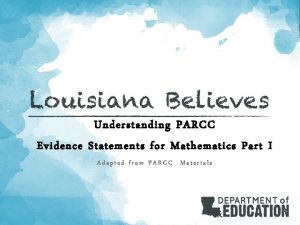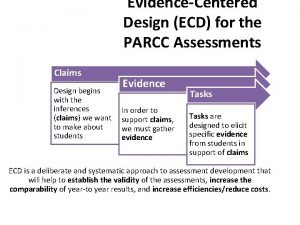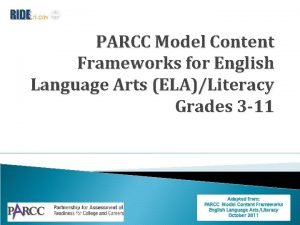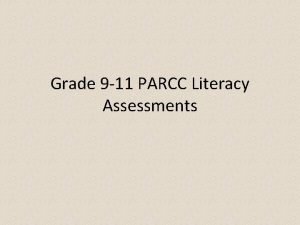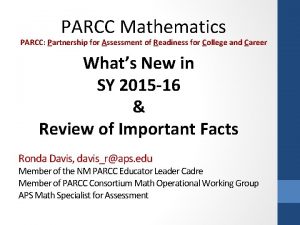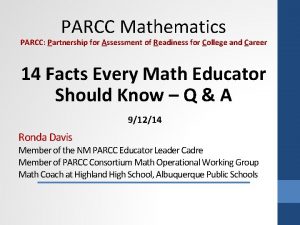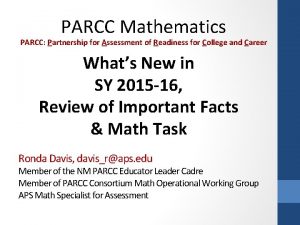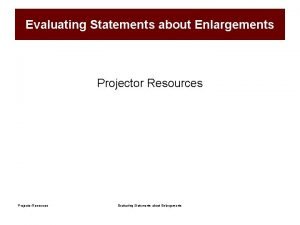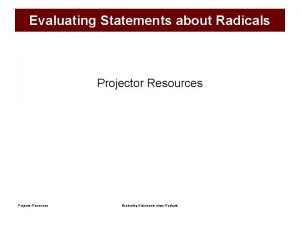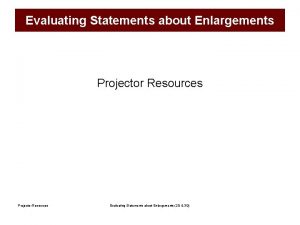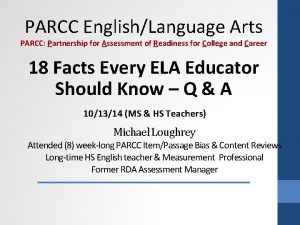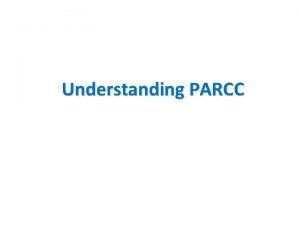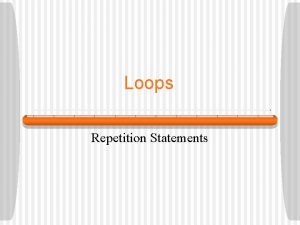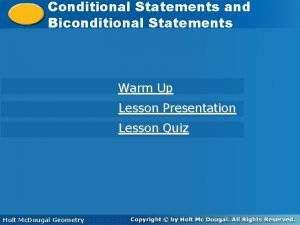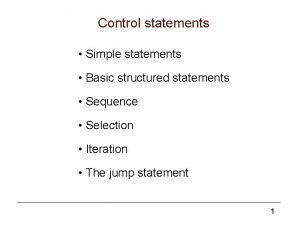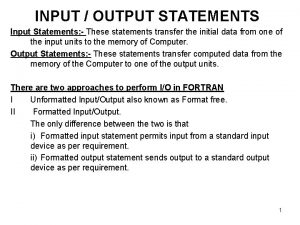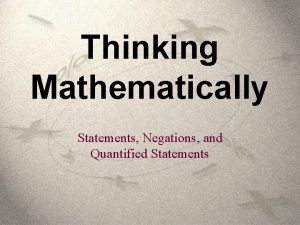PARCC Evidence Statements for Mathematics Part II Evaluating
































- Slides: 32

PARCC Evidence Statements for Mathematics Part II: Evaluating Tasks Adapted from PARCC Materials

Agenda PARCC’s Item Review Process Evaluating Sample Tasks Using PARCC’s Criteria Matching Tasks with Evidence Statements Creating Tasks based on PARCC Evidence Statements (time permitting) Louisiana Believes 2

Agenda PARCC’s Item Review Process Evaluating Sample Tasks Using PARCC’s Criteria Matching Tasks with Evidence Statements Creating Tasks based on PARCC Evidence Statements (time permitting) Louisiana Believes 3

Who are PARCC’s Item Reviewers? K-16 educators, state department of education staff, and external experts from PARCC states • Experience with students from various backgrounds • Many have participated in item reviews for their own states • Experience in various geographic and educational settings Louisiana Believes 4

PARCC Item Review Committees Various review teams meet, both in person and virtually, to evaluate the items over an extended period of time. Only items that are approved by these teams of reviewers will appear on the PARCC summative assessments. Louisiana Believes 5

Operational Working Groups • Content experts from state departments of education o ELA/Literacy o Mathematics o Accessibility, Accommodations, and Fairness (AAF) • Role in Item Reconciliation o Advise on conflicting opinions/issues after each item review o Includes members from content OWG and AAF OWG if there are item concerns after bias and sensitivity reviews Louisiana Believes 6

PARCC Item Review Meetings • Bias & Sensitivity teams are organized by grade band • Core Leadership* groups have 4 -5 reviewers per team • State Educator* and Bias & Sensitivity* teams have 6 -8 reviewers per team • Conducted both in-person and virtually, and last 3 – 5 days • Consist of independent review of items followed by group discussion * Led by an OWG member and facilitated by contractor staff Louisiana Believes 7

Summary of PARCC Item Review Process Items Develope d Core Leadershi p Review Louisiana Believes State Educator Review Bias & Sensitivity Review Field Test Item Bank 8

Mathematics Review Considerations/Criteria 1. Does the task measure the intended evidence statement(s)? 2. Does the task measure the intended mathematical practice(s)? 3. Is the task mathematically correct and free from errors? 4. Is the wording of the task clear, concise, and grade-level appropriate? 5. Are the graphics/stimuli in the task clear, accurate, appropriate for the task, and appropriate for the grade? 6. Do each of the prompts and all associated graphics/stimuli contribute to the quality of the task? 7. Is the scoring guide/rubric clear, correct and aligned with the expectations for performance that are expressed in the task? Louisiana Believes 9

Bias & Sensitivity Considerations/Criteria 1. Does the item disadvantage any population (gender, race, ethnicity, language, religion, socioeconomic status, disability or geographic region) for noneducationally relevant reasons? 2. Does the item contain controversial or emotionally charged subject matter that is not supported by the Common Core State Standards? 3. Is the item potentially offensive, demeaning, insensitive, or negative toward any population? 4. Does the item depict any population in a stereotypical manner? Louisiana Believes 10

Compare PARCC’s Item Review Process with Louisiana’s Process Louisiana Believes 11

Agenda PARCC’s Item Review Process Evaluating Sample Tasks Using PARCC’s Criteria Matching Tasks with Evidence Statements Creating Tasks based on PARCC Evidence Statements (time permitting) Louisiana Believes 12

General Steps for Item Reviews Step 1 - Read and work each task independently. Step 2 - Verify that the task aligns to the intended statement. evidence Step 3 - Determine if there any mathematical flaws in the task; i. e. , anything that makes the task unusable as written. (See next slide. ) Step 4 - Review answer keys and rubrics for accuracy. Step 5 - Advise to accept, accept with revision, or reject the task. Step 6 - Discuss with group. Come to consensus on acceptance and Louisiana Believes 13

Mathematics Review Considerations/Criteria 1. Does the task measure the intended evidence statement(s)? 2. Does the task measure the intended mathematical practice(s)? 3. Is the task mathematically correct and free from errors? 4. Is the wording of the task clear, concise, and grade-level appropriate? 5. Are the graphics/stimuli in the task clear, accurate, appropriate for the task, and appropriate for the grade? 6. Do each of the prompts and all associated graphics/stimuli contribute to the quality of the task? 7. Is the scoring guide/rubric clear, correct and aligned with the expectations for performance that are expressed in the task? Louisiana Believes 14

Sample 1 Task Type: I Points: 1 Evidence Statement: 3. NF. 2 This sample item was created for training purposes only. It is not an actual PARCC item. Louisiana Believes 15

Evidence Statement Text, Clarifications, Limits, Emphases and Other Information for 3. NF. 2 Evidence Statement Text Understand a fraction as a number on the number line; represent fractions on a number line diagram. a. Represent a fraction 1/ b on a number line diagram by defining the interval from 0 to 1 as the whole and partitioning it into b equal parts. Recognize that each part has size 1/ b and that the endpoint of the part based at 0 locates the number 1/ b on the number line. b. Represent a fraction a/b on a number line diagram by marking off a lengths 1/b from 0. Recognize that the resulting interval has size a/b and that its endpoint locates the number a/b on the number line. Louisiana Believes Clarifications, limits, emphases, and other information intended to ensure appropriate variety in tasks i) Fractions may include values greater than 1. ii) Fractions equal whole numbers in 20% of these tasks. iii) Tasks have “thin context” no context. 9 or iv) Tasks are limited to fractions with denominators 2, 3, 4, 6, and 8. (See footnote CCSSM, p 24). 16

Sample 3 Task Type: I Points: 1 Evidence Statement: 8. EE. 2 Which values represent solutions to the equation 2 64? Select all that apply. A) x = -16 D) x= 4 B) x=- E) x= C) x=-4 F) x 2 = x = 16 This sample item was created for training purposes only. It is not an actual PARCC item. 17

Evidence Statement Text, Clarifications, Limits, Emphases and Other Information for 8. EE. 2 Evidence Statement Text Clarifications, limits, emphases, and other information intended to ensure appropriate variety in tasks Use square root and cube root symbols to represent solutions to equations of the form x 2 = p and x 3 = p, where p is a positive rational number. Evaluate square roots of small perfect squares and cube roots of small perfect cubes. Know that 2 is irrational. i) Pool should contain tasks with and without contexts. ii) Tasks might for example take the form of algebraic word problems leading to equations x 2 = p or x 3 = p, or geometric problems such as finding the edge length of a cubical object with a given volume. iii) In problems where p and – p are both relevant as solutions to x 2 = p, both of these solutions should be given. Note that p is nonnegative by definition. iii) Solutions to equations x 2 = p or x 3 = p are represented as p or 3 p , respectively. iv) Manipulations such as 8 = 2 2 are beyond the scope of grade 8. Students need not simplify a solution such as 8. But students should ultimately express the following cases in the form of whole numbers: (a) the square roots of 1, 4, 9, 16, 25, 36, 49, 64, 81 and 100; (b) the cube roots of 1, 8, 27, and 64. Louisiana Believes 18

Sample 3 Task Type: I Points: 1 Evidence Statement: 7. NS. 2 b-2 This sample item was created for training purposes only. It is not an actual PARCC item. Louisiana Believes 19

Evidence Statement Text, Clarifications, Limits, Emphases and Other Information for 7. NS. 2 b-2 Evidence Statement Text Clarifications, limits, emphases, and other information intended to ensure appropriate variety in tasks Apply and extend previous understandings of multiplication and division and of fractions to multiply and divide rational numbers. c. Interpret quotients of rational numbers by describing real-world contexts. Louisiana Believes – 20

Sample 4 Task Type: I Points: 1 Evidence Statement: 6. G. 1 10 in. 5 in. 4 in. 14 in. This sample item was created for training purposes only. It is not an actual PARCC item. Louisiana Believes 21

Evidence Statement Text, Clarifications, Limits, Emphases and Other Information for 6. G. 1 Louisiana Believes 22

Sample 5 Task Type: II Points: 4 Evidence Statement: 5. C. 6/5. MD. 5 c Rosa needs to calculate the volume of a right prism. This diagram shows the dimensions of the prism. All angles in the base of the prism are right angles. 5 in. 4 in. 7 in. 6 in. 12 in. 11 in. Show Rosa can calculate the volume of the right prism. Be sure to explain why you chose the operations you use in your calculation, and include the volume of the prism. This sample item was created for training purposes only. It is not an actual PARCC item. Louisiana Believes 23

Evidence Statement Text, Clarifications, Limits, Emphases, Other Information for 5. C. 6 and 5. MD. 5 c Evidence Statement Key 5. C. 6 Evidence Statement Text Base explanations/reasoning on concrete referents such as diagrams (whether provided in the prompt or constructed by the student in her response). Clarifications, Limits, Emphases, and Other Information – Content Scope: Knowledge and skills articulated in 5. MD. C Relate the operations of multiplication and addition and solve real world and mathematical problems involving volume. c. Recognize volume as additive. Find volumes 5. MD. 5 c of solid figures composed of two nonoverlapping right rectangular prisms by adding the volumes of the non-overlapping parts, applying this technique to solve real world problems. Louisiana Believes i) Tasks require students to solve a contextual problem by applying the indicated concepts and skills. 24

Scoring Rubric for Sample #5 Scoring Rubric The task is worth 4 points; 1 point for computation and 3 points for reasoning. Computation component: 582 cubic inches Reasoning component: 1 point is awarded for a correct process in which the student shows or explains how to divide the prism into two (or more) right rectangular prisms 1 point is awarded for showing or explaining the correct calculations for determining the volume of each rectangular prism 1 point is awarded for showing or explaining that the volumes need to be added together to determine the volume of the entire prism. Louisiana Believes 25

Agenda PARCC’s Item Review Process Evaluating Sample Tasks Using PARCC’s Criteria Matching Tasks with Evidence Statements Creating Tasks based on PARCC Evidence Statements (time permitting) Louisiana Believes 26

Instructions for Matching Activity 1. Form groups of 3 -4. 2. Open your envelopes and remove the set of tasks. 3. Use the appropriate EOY Evidence Statement table to match each task to an Evidence Statement. 4. Record the Evidence Statement Key on the Group Recording Sheet. Please do not mark on the tasks. They will be used multiple times during the conference. Louisiana Believes 27

Agenda PARCC’s Item Review Process Evaluating Sample Tasks Using PARCC’s Criteria Matching Tasks with Evidence Statements Creating Tasks based on PARCC Evidence Statements (time permitting) Louisiana Believes 28

Developing the Stem 3. MD. 1 -1 Tell and write time to the nearest minute and measure time intervals in minutes. Assessment task clarifications: i) Time intervals are limited to 60 minutes. ii) No more than 20% of the items require determining a time interval from clock readings having different hour values. Acceptable intervals: ex. Start time 1: 20, end time 2: 10 – time interval is 50 minutes. Unacceptable intervals: ex. Start time 1: 20, end time 2: 30 – time interval exceeds 60 minutes. 3. MD. 1 -2 Solve word problems involving addition and subtraction of time intervals in minutes, e. g. , by representing the problem on a number line diagram. Assessment task clarifications: i) Only the answer is required (methods, representations, etc. are not assessed here). ii) Tasks do not involve reading start/stop times from a clock nor calculating elapsed time. Louisiana Believes 29

Determine and Create Scaffolding 3. C. 6 -2 Base explanations/reasoning on a number line diagram (whether provided in the prompt or constructed by the student in her response). Content Scope: Knowledge and skills articulated in 3. MD. 1 Tell and write time to the nearest minute and measure time intervals in minutes. Solve word problems involving addition and subtraction of time intervals in minutes, e. g. , by representing the problem on a number line diagram. Mathematical Practices associated with this content: MP. 3, MP. 5, and MP. 6 Louisiana Believes 30

Key Takeaways • The PARCC evidence statement tables are valuable tools that can and should be used in the classroom to inform instruction. • The PARCC sample items act as great instructional tasks to embedded in instruction. • Creating one’s own instructional tasks or lessons aligned to the PARCC evidence statement tables with not only prepare students for the PARCC Assessment, but, will prepare students to be College and Career Ready, as intended through the CCSS. Louisiana Believes 31

Learn More About PARCC Partnership for Assessment of Readiness for College and Careers www. parcconline. org On Twitter: @PARCCPlace #ask. PARCC Louisiana Believes 32
 Parcc evidence statements
Parcc evidence statements Parcc evidence statements
Parcc evidence statements Parcc model content frameworks
Parcc model content frameworks Parcc scoring guide
Parcc scoring guide Parcc writing prompts
Parcc writing prompts What does parcc stand for
What does parcc stand for Parcc
Parcc Primary evidence vs secondary evidence
Primary evidence vs secondary evidence Primary evidence vs secondary evidence
Primary evidence vs secondary evidence Primary evidence vs secondary evidence
Primary evidence vs secondary evidence Primary evidence vs secondary evidence
Primary evidence vs secondary evidence Jobs vancouver
Jobs vancouver Are fibers class evidence
Are fibers class evidence Class evidence vs individual evidence
Class evidence vs individual evidence Difference between physical and testimonial evidence
Difference between physical and testimonial evidence A pair of latex gloves was found at a crime scene
A pair of latex gloves was found at a crime scene Tu quoque
Tu quoque Iso 22301 utbildning
Iso 22301 utbildning Novell typiska drag
Novell typiska drag Tack för att ni lyssnade bild
Tack för att ni lyssnade bild Ekologiskt fotavtryck
Ekologiskt fotavtryck Varför kallas perioden 1918-1939 för mellankrigstiden
Varför kallas perioden 1918-1939 för mellankrigstiden En lathund för arbete med kontinuitetshantering
En lathund för arbete med kontinuitetshantering Personalliggare bygg undantag
Personalliggare bygg undantag Tidbok
Tidbok Anatomi organ reproduksi
Anatomi organ reproduksi Förklara densitet för barn
Förklara densitet för barn Datorkunskap för nybörjare
Datorkunskap för nybörjare Boverket ka
Boverket ka Hur skriver man en debattartikel
Hur skriver man en debattartikel För och nackdelar med firo
För och nackdelar med firo Nyckelkompetenser för livslångt lärande
Nyckelkompetenser för livslångt lärande Påbyggnader för flakfordon
Påbyggnader för flakfordon
